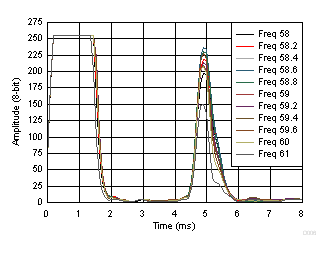SLAA732A February 2017 – April 2021 PGA460 , PGA460-Q1
5.1 Center Frequency
Pulse generation is achieved by a burst-control logic circuit with a pulse frequency that can be configured from 30 kHz to 80 kHz in 251 steps, or from 180 kHz to 480 kHz, and is configured by the FREQ bit in the PGA460 EEPROM. Given the 200-Hz step resolution, the optimal resonance frequency can be located if the transducer is swept within its specified range of tolerance.
The example in Figure 5-1 shows how much the returning peak amplitude can vary when execute a burst and listening cycle at each frequency value within a ±2-kHz single-increment sweep for the nominally 58.5-kHz transducer. In this example, a frequency of 58.6 kHz produced the best peak result, without extending the decay time.
 Figure 5-1 Echo Data Dump for Resonant Frequency Sweep of 58.5-kHz Transducer
Figure 5-1 Echo Data Dump for Resonant Frequency Sweep of 58.5-kHz Transducer